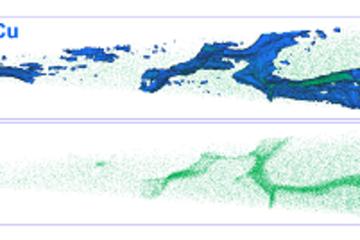All genres
81.
Talk
Atomistic study of dislocation mobility and obstacle hardening in bcc-Fe: versatility of embedded atom method potentials. MMM2014, 7th International Conference on Multiscale Materials Modeling
, Berkeley, CA, USA (2014)
82.
Talk
Recent development of modelling techniques in nano- and meso-scale simulations of dislocation dynamics. Workshop on Integrated Computational Materials Engineering (ICME), Rolduc Abbey, The Netherlands (2014)
83.
Talk
kappa-carbides as precipitates in austenitic steels: Ab initio study of structural, magnetic and Interface properties. EUROMAT 2013, Sevilla, Spain (2013)
84.
Talk
Nano-to-macro-scale modeling of hierarchical biocoposites. SPP 1420 Summer School, UIm, Germany (2013)
85.
Talk
Arthropod cuticle: A biological multi-functional composite used as template for nano-to-macro-scale hierarchical modeling. Seventh International Conference on Materials Structure and Micromechanics of Fracture, Brno, Czech Republic (2013)
86.
Talk
Combined theoretical and experimental studies of ductile Mg alloys. Seminar lecture at the Technical University Bergakademie Freiberg, Freiberg, Germany (2013)
87.
Talk
Combined theoretical and experimental studies of ductile Mg alloys. International Symposium on Atomistic Modeling for Mechanics, Tokyo, Japan (2013)
88.
Talk
Nanostructures in 1 Billon Tons: Interface Engineering in Complex Steels and Biological Nanocomposites. Materialwissenschaftliches Kolloquium, Universität Hamburg-Harburg, Hamburg, Germany (2013)
89.
Talk
Arthropod cuticle: A biological multi-functional composite used as template for nano-to-macro-scale hierarchical modeling. Advanced Materials 2013, Zhenjiang, China (2013)
90.
Talk
Structural interfaces enable function-related variations of properties exoskeletal elements of Crustacea. MRS Spring Meeting 2013, San Francisco, CA, USA (2013)
91.
Talk
Ab initio study of kappa-carbides as precipitates in austenitic Fe matrix. DPG Frühjahrstagung 2013, Regensburg, Germany (2013)
92.
Talk
Fe3Al surfaces in dry and humid oxygen atmosphere. DPG Frühjahrstagung, Regensburg, Germany (2013)
93.
Talk
Comparison of the mechanical behavior of exoskeletal parts from different Crustacea – Experiments and Modeling. MRS Fall Meeting 2013, Boston, MA, USA (2013)
94.
Talk
Self-consistent scale-bridging approach to compute the elasticity of multi-phase polycrystals. DPG Frühjahrstagung, Regensburg, Germany (2013)
95.
Talk
Ab initio study of thermodynamic, electronic, magnetic, structural, and elastic properties of Ni4N allotropes. DPG Frühjahrstagung, Regensburg, Germany (2013)
96.
Talk
Ab initio stacking fault energy calculations in Mg–Y alloys. DPG Frühjahrstagung, Regensburg, Germany (2013)
97.
Talk
Ab initio study of stacking fault energies in Mg alloys. European Congress and Exhibition on Advanced Materials and Processes, Sevilla, Spain (2013)
98.
Talk
Ab initio study of single-crystalline and polycrystalline elastic properties of Mg-substituted calcite crystals. DPG Frühjahrstagung, Regensburg, Germany (2013)
99.
Talk
The Multiscale Modeling of Biomaterials as a Tool for Understanding the Design Principles in Nature. IVth National Crystallographic Symposium, Sofia, Bulgaria (2012)
100.
Talk
Combining ab initio calculations and high resolution experiments to improve the understanding of advanced Mg-Y and Mg-RE alloys. 7th Annual Conference of the ARC Centre of Excellence for Design in Light Metals, Melbourne, VIC, Australia (2012)











